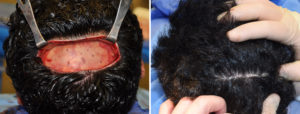In any form of skull reshaping surgery scalp incisions are needed. While every effort is made to keep them as short in length as possible, some incisional length is needed with a resultant scar. Such scalp scars are unavoidable The question from patients is always what does the scar look like and how does it heal afterwards.

In my experience in performing aesthetic skull reshaping surgery, I have made ten observations about the resultant scars from the scalp incisions.
- Making the incisions with ‘cold steel’ (scalpels) has the lowest risk of injuring hair follicles. (lasers and electrocautery make for the worst scalp scars)
- Incisions must be made paralleling how the hair shaft exists the scalp to prevent injury to hair follicles.
- Closure of the scalp incision should be done with deep galeal sutures and either fine skin sutures or small metal clips. The dermis (underside of the skin) should not be sutured to prevent injury to hair follicles. There are no scar differences between small sutures or metal clips.
- Scalp scars do best on the top and back of the head. Scalp incisions on the sides of the head (temporal region) have a tendency to widen a bit in some patients.
- Scalp scars do very well in bald or shaved heads in men. They often do better than in patients with hair.
- Scar widening is more likely in skull augmentation than skull reduction procedures. Less tension on the wound closure equals a more narrow scar.
- Longer scalp incisions have a greater risk of scar widening than smaller scalp incisions, presumably due to the magnitude of the procedure done. Although more incision length in general increases the risk of scar widening by virtue of its greater length.
- Ethnicity does not change the risk of how the scar heals. Darker skin pigments do not have increased adverse scalp scars than that of Caucasians.
- I have never seen a scalp scar keloid, only scar hypertrophy. (widening)
- Repeated entry into the same scalp scar increases the postoperative risk of widening.
Dr. Barry Eppley
Indianapolis, Indiana


